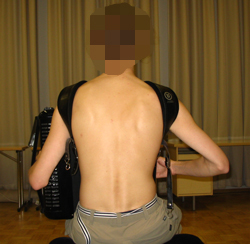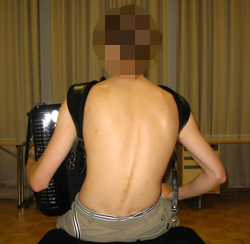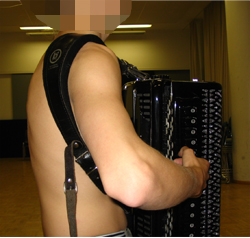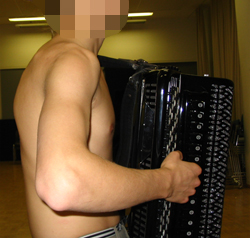Accordion - harjoittelu
Accordion
Read the Ergonomics Overview first.
The body's centre position is the basic position to which the musician always returns. In the centre position, the spine maintains its natural curves. Spinal curves vary between individuals; in the centre position, the backs and hips of different people may look different.
Accordion players should first examine the position of their pelvis. As a rule, the pelvis should be maintained in its centre position, retaining the natural arc of the lumbar spine and facilitating muscular support for the pelvis and lumbar spine. When pushing the bellows, the centre of mass moves slightly to the right, returning to the centre when the musician pulls the bellows. Accordions are heavy instruments, and moving the bellows requires good support in the lumbo-pelvic (midriff) region. Accordionists benefit from strong deep muscles that maintain the posture, as well as strong oblique abdominal muscles. Accordionists are prone to excessively curving the lumbar spine and twisting it to the left; the body's centre of mass can easily move too far to the right.
|
Pelvis and spine in the centre position. |
The pelvis is tilted backward, the spine is twisted to the left and the centre of mass is too far right. |
Faulty sitting postures cause a lot of lower back problems for accordionists. In worst case scenario, they can cause a more serious back problem, namely, a herniated disc.
Accordionists often push their head forward. This is probably down to using chin registers and the fact that the musician is looking at his or her right hand. In addition to maintaining the pelvis, the lumbar spine and the thoracic spine in the centre position, musicians should also return the cervical spine and the head to the centre position whenever possible. If the head remains pushed forward, the strain on the neck muscles and the base of the cervical spine increases.
Good muscular support of the left shoulder blade allows for straight and free bellows motion. If the shoulder blade is insufficiently supported, it tilts forward, wings off of the rib cage, and the bottom corner ! rotates towards the spine. The upper arm becomes tense, the left elbow moves far behind the shoulder, and the bellows move further back. Because of this error, problems in the left shoulder joint region are relatively common among accordionists.
It is also important for the right shoulder blade to be well supported. With insufficient support, the shoulder blade tilts forward, causing the elbow to move further back from the shoulder, and the wrist becomes bent. This error is particularly strenuous on the forearm, the wrist and the right hand side neck and shoulder area. When the position of the shoulder blade is corrected, the elbow and the shoulder are aligned when viewed from the side, and the wrist maintains its 15 degree extension.
|
Right shoulder blade is correctly supported; the elbow stays aligned with the body when the wrist is straight. |
|




